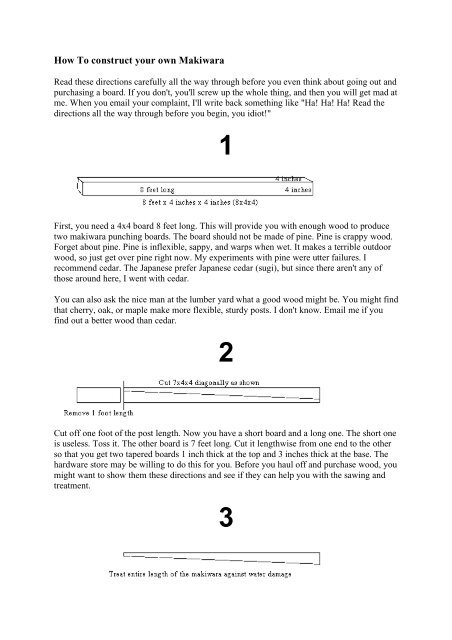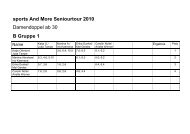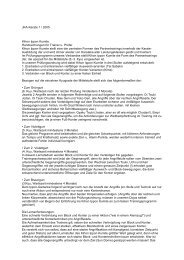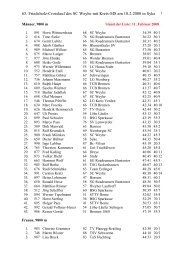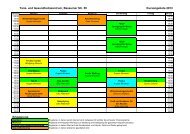How To construct your own Makiwara - FTSV Jahn Brinkum
How To construct your own Makiwara - FTSV Jahn Brinkum
How To construct your own Makiwara - FTSV Jahn Brinkum
- No tags were found...
You also want an ePaper? Increase the reach of your titles
YUMPU automatically turns print PDFs into web optimized ePapers that Google loves.
<strong>How</strong> <strong>To</strong> <strong>construct</strong> <strong>your</strong> <strong>own</strong> <strong>Makiwara</strong>Read these directions carefully all the way through before you even think about going out andpurchasing a board. If you don't, you'll screw up the whole thing, and then you will get mad atme. When you email <strong>your</strong> complaint, I'll write back something like "Ha! Ha! Ha! Read thedirections all the way through before you begin, you idiot!"1First, you need a 4x4 board 8 feet long. This will provide you with enough wood to producetwo makiwara punching boards. The board should not be made of pine. Pine is crappy wood.Forget about pine. Pine is inflexible, sappy, and warps when wet. It makes a terrible outdoorwood, so just get over pine right now. My experiments with pine were utter failures. Irecommend cedar. The Japanese prefer Japanese cedar (sugi), but since there aren't any ofthose around here, I went with cedar.You can also ask the nice man at the lumber yard what a good wood might be. You might findthat cherry, oak, or maple make more flexible, sturdy posts. I don't know. Email me if youfind out a better wood than cedar.2Cut off one foot of the post length. Now you have a short board and a long one. The short oneis useless. <strong>To</strong>ss it. The other board is 7 feet long. Cut it lengthwise from one end to the otherso that you get two tapered boards 1 inch thick at the top and 3 inches thick at the base. Thehardware store may be willing to do this for you. Before you haul off and purchase wood, youmight want to show them these directions and see if they can help you with the sawing andtreatment.3
Treat the boards against water damage by painting them with a compound designed foroutdoor wood structures made of cedar or whatever wood you are using. Follow the directionsof the guy at the hardware store carefully, and read the directions on the can. Make as manyapplications as possible. Be patient, and do this right. If you skip this step, or if you don'tfollow the directions on the product you use to treat the post, it will rot underground and snapoff when you punch it. You'll think you're pretty cool when you punch it and it breaks in half,until you realize that you now do all of this over again. ARG!4Dig a hole about 1.5 feet wide and about 3 feet deep. Be careful to put the dirt far enoughaway from the hole that it doesn't spill back in as you dig it. Recommended tools: a post holedigger to dig hole and a wheel barrel to hold dirt. A post hole digger looks like two shovelsswiveled together. A wheel barrel is a big wagon with one wheel in front. If you put the dirtyou dig up in it, you won't be standing in mud when you try out <strong>your</strong> new punching board.Another good tool is a shovel that is long, sharp, and round. Make sure any shovel or holedigger you purchase has very wide supports for you to put <strong>your</strong> feet when you step on it to digthe hole. If the supports for <strong>your</strong> feet are narrow, then you will have really sore feet very fast.And, Pete Rogers recommends that you also use a spirit level to ensure that the makiwara postis vertical. A sanding plane won't hurt anything either, since you'll need it to adjust theflexibility of the board later... but not too much!5
Plant the makiwara in the hole fat end d<strong>own</strong>. The flat side will be the place where you hit it,not the angled side. So, make sure it is facing where you prefer to stand. I like to put mineright next to a patio so I can stand on concrete when I hit it. Next to the driveway is cool, too,but <strong>your</strong> neighbors will wonder what the hell you are doing, and then you'll have to gothrough all of the usual "Are you a black belt?" crap. Notice that in my example, I'll end upstanding in my dirt. I put my dirt on the concrete so I don't have to destroy my lawn to fillback in the hole. You should put <strong>your</strong>s in a wheel barrel if you can't put it next to concrete.6In front of the base of the makiwara in the hole, place a thick board or a brick to prevent thepost from moving in the ground. When you fill in the hole, tamp the dirt d<strong>own</strong> nice and tightevery time you fill it in with another 6 inch covering. At the top of the hole, plant a brick orsturdy board behind the makiwara post's tapered side. You will punch the flat side after it isfinished. This brick or board will keep the makiwara from moving in the hole.Or, even better, you could fill the hole with cement, and the makiwara would be locked in.The problems with this include lots of hard work mixing cement in an $80.00 wheel barrow,which is now ruined by cement drying in it. The makiwara could dry in the cement crooked,resulting in an idiot with a useless makiwara. The makiwara might not be removable. If youdo it this way, pour the cement around the makiwara, and then pull the board out after itsettles just a little.One of my friends, Timothy Dobbins, planted his <strong>own</strong> makiwara by his driveway. I must sayhe did a superior job of installing it, and I was quite impressed with his work. He made the
hole loose enough for the makiwara to be removed at night. He stored the board in his garage.When he wanted to hit it, he simple dropped the makiwara into the hole, placed a woodenchock behind the board to keep it steady in the hole, and then punched away on it.When he was done, he pulled up the chock, pull out the makiwara, and put it inside. He evenburned a Shotokan Tiger on the makiwara. It was a sweet setup. Tim is able to do this type ofthing because he is that kind of man who can pour his <strong>own</strong> slab and then build his <strong>own</strong> house.He can even do the wiring. You might prefer my poor man's method of building <strong>your</strong>makiwara. If you have the ability, though, definitely do it Tim's way, and tell <strong>your</strong> friends it isa "Dobbins <strong>Makiwara</strong>."7Use a planing tool to shave off wood and eliminate any over-stiffness in the play of themakiwara. After planing, treat the affected makiwara surfaces against water damage.8Use duct tape to apply a pad, and cover the pad with leather.9
Your makiwara is now ready for use! You built it <strong>your</strong>self, so no matter the imperfections init, you have accomplished something. If you made the kind of makiwara that is removable,you genius you, then only bring it outside when you want to hit it, and then bring it backinside. That kind of makiwara will last a very long time. If <strong>your</strong> makiwara is permanentlyfixed outdoors, you can find some sort of long, plastic container to place on it upside d<strong>own</strong> sothat the pad and the top of the board never get wet when it rains.<strong>Makiwara</strong> Training TipsFailure to heed my advice about training on <strong>your</strong> makiwara is tantamount to treason. I justtaught you how to build <strong>your</strong> very <strong>own</strong> and even how to read the Japanese characters formakiwara. And now you think I don't know it all when it comes to training advice? Wrong!You will carefully think about each and every one of the following recommendations becauseyou know you should.• Don't ever hit pure concrete with <strong>your</strong> hands. Although this is detailed in C.W. Nicol'sMoving Zen as a training method, it is dangerous and probably will cause extensivedamage. It is not useful for training. The purpose of the makiwara is not to conditionthe knuckles. The purpose of the device is to condition the muscles in the armpit area,the legs, and the hips. C.W. Nicol is wrong, and I'm right. Ignore his bad conditioningadvice and maniacal ideas about punching concrete.• When you punch the makiwara, make a feeling as if you are straightening <strong>your</strong> elbowin order to strike it. This will create correct muscle usage. Of course, <strong>your</strong> elbowshould never become perfectly straight. Stand close enough to the makiwara that youcan stop extending <strong>your</strong> arm before <strong>your</strong> elbow becomes straight and still get fullpenetration into the board.• The makiwara has certain advantages over the hanging heavy bag. The makiwaraincreases in resistance as <strong>your</strong> knuckles burrow into it. That means that when youstrike it, rather than having a single resistance weight, it is scalable and alwaysprovides you with more resistance no matter how hard you strike it.• If you are able to punch the makiwara and then hold that position against it'sresistance, it means <strong>your</strong> punch was controlled and weak. The makiwara only pushesback as hard as you hit it. Do not tense any antagonist muscles on impact with themakiwara. Only tense those muscles that are pushing the fist into the board. Youshould not be able to resist the reaction force of the board.• Try to think about how you can make <strong>your</strong> legs do the punching. Stand in a frontstance and punch with the hips straight forward. Connect <strong>your</strong> rear foot to themakiwara by lifting the front foot. Lifting the front foot even 1/4 inch off of theground will move nearly 40% of <strong>your</strong> weight from that limb to the punching hand andrear foot. The increase in force is so dramatic that you may injure <strong>your</strong>self. Be careful.• The makiwara prepares you to punch someone in the chest simultaneously when theypunch you, and to resist that force strongly and not give in. The makiwara is an
excellent tool for exploring punching techniques useful when standing <strong>your</strong> ground.Stepping punches don't work very well against a makiwara. Use the reverse punch.• Don't kick <strong>your</strong> punching makiwara. It will break if it is the right consistency forpunching.• Use the makiwara at least two days per week, no more than 6 days per week. Punch itusing the basic reverse punch at least 30 times on one side before resting and movingto the other side.• You can use the makiwara to learn control by snap punching it lightly (just touch it -barely) with extremely fast repetitions of 10-30 times on each side without hiprotation. Once you can control, try this on a concrete wall. Then a human. The goal isnot conditioning, but control. Be careful.• Don't bother punching the makiwara from horse riding stance. This stance wasdesigned to be used from the SIDE. It will not support forward techniques, eventhough this is a training method of great importance for other technical reasons.• After learning to reduce surface area, reduce it further to increase damage by usingonly the index finger knuckle.• Check to make sure that you never strike with the upper surface of the index fingeritself, only the knuckle.• Do not raise the back foot's outer edge off of the floor to punch. This indicates insidetension in <strong>your</strong> stance, not outside as the front stance requires. Move the hips LEFT-RIGHT in order to correct this alignment error. You should feel <strong>your</strong> rear foot pushingbackward behind you as <strong>your</strong> fist pushes forward into the makiwara on every punch. Ifyou don't feel this, you are punching only with <strong>your</strong> arm.• Check, or have someone check, to make sure that you never lean forward or leanbackward during the draw or the punch.• Without some form of resistance training, such as a makiwara, <strong>your</strong> techniques will beweak and you will be conditioned to only focus <strong>your</strong> blows, never to punch withoutcontrol full force.• Don't punch the makiwara when you have scabs on <strong>your</strong> knuckles. Hell, you mightcatch AIDS if someone else is sharing the makiwara with you. Bleeding on a public orshared makiwara is irresponsible and rude. If you start to bleed, stop punching theboard. Scabs protect us from infections. If you open <strong>your</strong>s up, then you might getsomething like a flesh-eating bacteria in <strong>your</strong> hand. Let <strong>your</strong>self heal.• A foam rubber beer can cozy is a great way to keep beer cold and <strong>your</strong> hands warm.Just slide the beer d<strong>own</strong> into the cozy, and you can enjoy a cold one without freezing<strong>your</strong> fingers off. That cozy also makes a great makiwara pad. Tear off the bottom, tearit lengthwise, and tape it on with duct tape on each end. That foam rubber has just theright resistance.• Don't waste <strong>your</strong> time striking with techniques other than punching. Punching is theonly motion that truly uses the full body and benefits from the makiwara.• Those calluses mean that you are either hitting <strong>your</strong> makiwara wrong or have built abad one. Make sure the pad is not rough, and make sure that <strong>your</strong> board has enoughflexibility.• The makiwara does not build speed. It does build some strength, but not much. Mostlywhat it does is teach joint alignment. It also teaches you drive <strong>your</strong> hand into the targetwith <strong>your</strong> legs. And, if you experiment, it will teach you how to unweight <strong>your</strong> frontfoot in order to increase the weight you are using to punch with.• Conditioning the hands is for losers.


